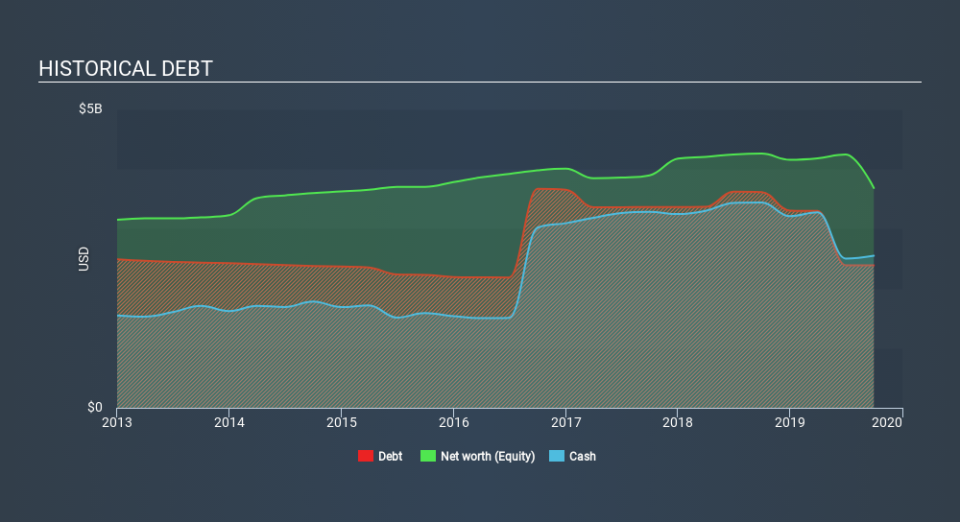Does EchoStar (NASDAQ:SATS) Have A Healthy Balance Sheet?

Howard Marks put it nicely when he said that, rather than worrying about share price volatility, 'The possibility of permanent loss is the risk I worry about... and every practical investor I know worries about. It's only natural to consider a company's balance sheet when you examine how risky it is, since debt is often involved when a business collapses. We note that EchoStar Corporation (NASDAQ:SATS) does have debt on its balance sheet. But the more important question is: how much risk is that debt creating?
Why Does Debt Bring Risk?
Debt assists a business until the business has trouble paying it off, either with new capital or with free cash flow. Part and parcel of capitalism is the process of 'creative destruction' where failed businesses are mercilessly liquidated by their bankers. However, a more common (but still painful) scenario is that it has to raise new equity capital at a low price, thus permanently diluting shareholders. By replacing dilution, though, debt can be an extremely good tool for businesses that need capital to invest in growth at high rates of return. When we think about a company's use of debt, we first look at cash and debt together.
See our latest analysis for EchoStar
What Is EchoStar's Debt?
The image below, which you can click on for greater detail, shows that EchoStar had debt of US$2.39b at the end of September 2019, a reduction from US$3.61b over a year. However, its balance sheet shows it holds US$2.55b in cash, so it actually has US$159.2m net cash.
How Healthy Is EchoStar's Balance Sheet?
According to the last reported balance sheet, EchoStar had liabilities of US$461.7m due within 12 months, and liabilities of US$2.89b due beyond 12 months. Offsetting these obligations, it had cash of US$2.55b as well as receivables valued at US$216.9m due within 12 months. So it has liabilities totalling US$589.6m more than its cash and near-term receivables, combined.
Given EchoStar has a market capitalization of US$3.80b, it's hard to believe these liabilities pose much threat. However, we do think it is worth keeping an eye on its balance sheet strength, as it may change over time. While it does have liabilities worth noting, EchoStar also has more cash than debt, so we're pretty confident it can manage its debt safely.
Importantly, EchoStar grew its EBIT by 71% over the last twelve months, and that growth will make it easier to handle its debt. The balance sheet is clearly the area to focus on when you are analysing debt. But it is future earnings, more than anything, that will determine EchoStar's ability to maintain a healthy balance sheet going forward. So if you want to see what the professionals think, you might find this free report on analyst profit forecasts to be interesting.
But our final consideration is also important, because a company cannot pay debt with paper profits; it needs cold hard cash. EchoStar may have net cash on the balance sheet, but it is still interesting to look at how well the business converts its earnings before interest and tax (EBIT) to free cash flow, because that will influence both its need for, and its capacity to manage debt. During the last three years, EchoStar produced sturdy free cash flow equating to 79% of its EBIT, about what we'd expect. This free cash flow puts the company in a good position to pay down debt, when appropriate.
Summing up
Although EchoStar's balance sheet isn't particularly strong, due to the total liabilities, it is clearly positive to see that it has net cash of US$159.2m. And it impressed us with its EBIT growth of 71% over the last year. So we don't think EchoStar's use of debt is risky. We'd be motivated to research the stock further if we found out that EchoStar insiders have bought shares recently. If you would too, then you're in luck, since today we're sharing our list of reported insider transactions for free.
If, after all that, you're more interested in a fast growing company with a rock-solid balance sheet, then check out our list of net cash growth stocks without delay.
If you spot an error that warrants correction, please contact the editor at editorial-team@simplywallst.com. This article by Simply Wall St is general in nature. It does not constitute a recommendation to buy or sell any stock, and does not take account of your objectives, or your financial situation. Simply Wall St has no position in the stocks mentioned.
We aim to bring you long-term focused research analysis driven by fundamental data. Note that our analysis may not factor in the latest price-sensitive company announcements or qualitative material. Thank you for reading.

 Yahoo Finance
Yahoo Finance 
